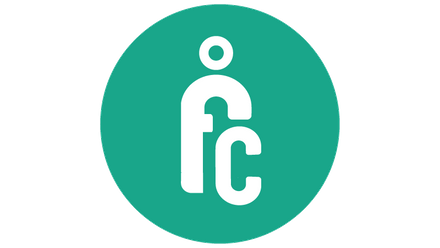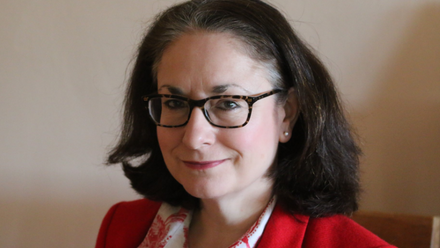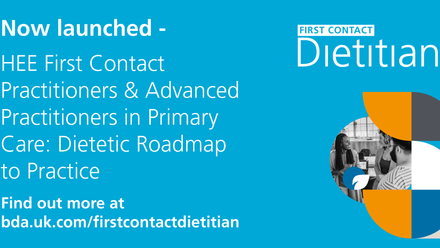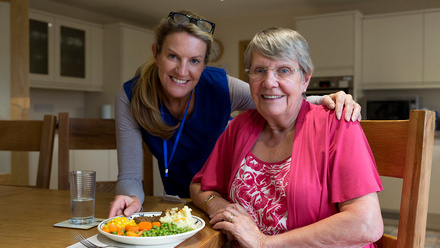Are you considering a career in Primary Care as a First Contact Dietitian? The BDA is here to support you to move into this exciting, emerging area of practice. In this article, we hear what a day might look like as a First Contact Dietitian*
08.15am – I log in to the clinical system to see who is booked into my clinic. My clinics are set up to run face to face, all are 30-minute appointments with 50% booked on the day and 50% booked in advance.
08.28am – My screen changes to alert me that my first patient has arrived, having been booked in from reception triage just this morning. I press the key to call them into the clinic room and have the four minutes I know it takes them to walk down the corridor to read their notes to get an idea of why they are booked in to see me.
08.32am – Jessica is 24 years old and has abdominal cramps and bloating. I take a full history of her symptoms and explore Jessica’s Ideas, Concerns and Expectations1. Jessica worries about the bloating as on days when it is bad, she has had people ask if she is pregnant. Jessica and I agree that we will conduct some initial blood tests and when we have these results, we can agree next steps. I order the agreed blood tests on the clinical system and book a follow up appointment for 10 days’ time. Jessica thanks me for my time and lets me know that she feels reassured.
09.09am – My next patient has also been booked in to see me on the same day after phoning reception and requesting an assessment with the first contact dietitian. Jason is 32 and has been off work for the last 6 weeks due to lower back pain. I can see from his notes that he has recently been seen by the First Contact Physiotherapist, who has advised Jason to get support to manage his weight as his lower back pain is likely exacerbated by having a high body mass index (BMI). Jason feels that it’s a good time for him to address his weight and therefore has requested this appointment. I take his blood pressure, review and discuss his recent HbA1c and lipids, we discuss his family history of heart disease, smoking etc to allow me to calculate his QRISK score and to see what referral options are available. Using a patient-centred approach, Jason and I agree that he would benefit from being referred into the local weight management groups offered by the community dietetic team. We discuss goals and I task the admin team with actioning the referral for the groups. Jason and I agree that he will make further appointments with me in future depending on his progress with the groups.
09.30am – The next patient is in the waiting room, also booked in on the day and it’s a child. I can see from their notes that they have already seen the GP this morning who has assessed for any worrying signs and symptoms and the GP wishes for me to speak with the family about selective eating. This, I know I can do. Coming from an adult background, I always worry about seeing children but as per my agreed scope of practice, I only see infants and children who have been referred following an assessment by a GP. This consultation goes very well and mum and child leave with mum reporting she feels reassured and confident with the plan we have put in place. I have not booked a follow up appointment, but importantly, I have provided safety netting advice so that the mum knows what to look for and when to call the practice for further support.
09.52am – I’ve now managed to get ahead of schedule as my next person is due at 10am and hasn’t arrived yet so it’s a quick trip out of my room to get a drink. The rest of my morning appointments are pre-booked so I can relax a bit. On the way, one of my GP colleagues, Nisha, stops me to ask a question about a patient she has seen that morning who has a stoma. Nisha wants to know whether they still need the magnesium that’s on their acute prescription. We discuss the case and I agree to have a look at the notes and let her know.
10.05am – I call my next patient and can see that this is an Orlistat review. As a non-medical supplementary prescriber, I see all the Orlistat reviews within the practice as it’s a caseload that the dietitians can manage well that frees up significant amounts of GP appointments. I call the person in, take their weight and discuss their progress – they’ve lost another 3kgs since last month, amazing! Although I’m a non-medical prescriber, I haven’t yet been able to get my name added to issue prescriptions so I send a quick task to the GP to request they authorise the next month’s prescription. As I have been seeing this person for a while, I already have a clinical management plan in place and at each appointment, I will check to ensure that no new medications have been started and provide drug counselling.
10.28am – I have a welcome structured 30-minute admin break in the middle of my morning. This is a very important part of my day as it’s an opportunity to leave my clinic room, make a cup of tea and most importantly – mix with the other members of the Primary Care team who are doing the same. The practice gives everyone a 30-minute mid-morning and mid-afternoon break for this exact reason – otherwise you could go all day in your room without interacting with any of your work colleagues. For me, it’s an opportunity to have a quick debrief with one of the GPs (who happens to be my supervisor) following my morning patients. I summarise my consultation with Jessica, my supervisor asks a few probing questions to explore my thoughts on what I will be looking for at the review and we agree that this will be a great case-based discussion to bring along to my next formal supervision session in 3 weeks’ time.
10.57am – Back in my room and the next consultation is a phone review for Brenda - a housebound patient who has not long been discharged from hospital. She has declined input from the local community dietetic service as she doesn’t want lots of people visiting her at home. I find that it is common in Primary Care to identify patients who need health care professions input, but will only engage with their GP practice. The community nurses have been checking her weight and she is slowly gaining weight, but her BMI is still only 15kg/m2 and she has an improving category 2 pressure ulcer. Whilst it’s challenging to get all the information I need over the phone, I respect Brenda’s wishes and know that if I didn’t contact her in this way, she would not get the dietetic support she so obviously needs. Brenda has been on 2 nutritional supplements per day for the last 4 weeks, we discuss food fortification options now she is at home and agree a review for 6 weeks’ time. I try to limit the number of follow up appointments I book for people but I know Brenda needs this.
On this occasion, no change to the nutritional supplements was required, however if a change was required, as per agreement with the practice, I’d make the amendments to the prescription on the system and send to the GP for it to be issued. I can do this, regardless of my status as a non-medical prescriber because supplements are not prescription only medicines. I would of course, as with any dietetic intervention, ensure there are no contraindications for the supplements (such as allergy/drug interactions) and provide appropriate counselling where this is needed. Examples include ensuring the correct IDDSI level and checking cultural and personal requirements (such as Halal/vegan/vegetarian).
11.33am – The last person of the morning is Dave and he is in the waiting area. I saw Dave last week and based on his history and symptoms, we ordered blood tests that included a coeliac screen. I quickly check the IgA tissue transglutaminase (tTG) result before calling him in and it’s 55 U/ml. When he arrives, I can see that he is nervous. Dave has a strong family history of coeliac disease and has seen how other family members have managed this. We discuss the results and I explain, in detail, that it’s not conclusive but highly suggestive of coeliac disease and that a biopsy will be needed to provide a definitive answer. Dave has lots of questions about this, some I can answer, but for some of them (for example the wait time) I advise Dave that I don’t know but will find out and let him know. I ensure Dave knows that he must keep eating gluten up until his biopsy and that I will get back to him when I have answers to his other questions.
12.04pm – I am relieved that it’s the last appointment of the day for me as I have never referred anyone for oesophago-gastro-duodenoscopy (OGD) and duodenal biopsies before so I need to find someone who can help me. I go to see who is in the staff room and Rich the Advanced Practice paramedic is there. Unfortunately, he has also never done this before, so I go and knock on the door of the duty doctor, Jenny. Jenny is always super helpful, but I can tell she is under pressure today. I explain that I need her help with Dave, we discuss what needs to happen – she acknowledges it needs sorting out soon but it’s not urgent so we schedule a time when we can go through this together at the end of the week. In the meantime, she gives me some advice on how to find the answer to Dave’s questions. Only a very quick 5-minute chat with Jenny but super important and helpful in ensuring I’m not going to spend lots of time worrying that I had missed something with Dave.
1.00pm – After a quick walk and sandwich for lunch it’s service development time for me this afternoon. In line with the recommendations made by Health Education England, my time is spent with an 80% split of clinical time alongside 20% of time for development2. The PCN have highlighted some priority areas that they want the dietitian to support and I’ve been tasked with developing a plan for this. As part of the enhanced health in care homes3, people living in care homes should expect the same level of support as if they were living in their own home. The PCN therefore are aspiring for better collaboration between community and Primary Care providers. For me this means working with the community dietetic team, who are commissioned to deliver diabetes structured education, to agree how we can better provide this education so that it meets the needs of all residents whether in their own home or a care home. I did not know the community dietetic service before this role so found their contact details via the internet and arranged a virtual meeting to get to know the team and how best to work together to ensure system wide benefits.
3.30pm – I’ll be in a different practice tomorrow and won’t be here for another week so I always try to finish my day by ensuring there are no outstanding tasks. I’ve researched and found the answers out for Dave’s questions and use Accurx to text him. I am meeting with Jenny on Friday afternoon in my other protected development session, so that we can refer him to the local secondary care trust for his OGD and biopsies.
I’ve gone through my emails and tasks from the multi-professional general practice team. Just as I’m about to log off, I remember that I agreed to check the stoma patient for Nisha. I look through the notes and I can’t see any letters to suggest that he is known to the hospital team so I call the community dietetic service. They advise that he did not attend his last appointment and so was discharged from the service as per local policy. I reflect on what an eye-opening experience it has been for me working in Primary Care where we cannot simply discharge patients. I decide the safest thing to do is probably for me to fully assess the patient notes so that I can advise the GP appropriately. Fortunately, I see that I have a free slot in my clinic in the morning so I make a note to myself to use that time to do this. I send a quick message to Nisha to let her know my plan so she knows I haven’t forgotten and its home time.
Working in Primary Care as a first contact dietitian pushes me to my limits clinically every day. It’s hard work but hugely rewarding being at the start of a person’s journey, ensuring they are seen by the right clinician and given the right advice and treatment at the first point of contact into the health service. Primary Care also allows me to address some of the health inequalities that are created by the system where strict referral criteria or access policies may mean that those patients who would most benefit from dietetic intervention often do not receive it.
Fortunately, I feel I have a supportive network of colleagues but this has taken me a lot of time and initiative to establish. For example, before I accepted the job offer, I checked that the PCN offered a CPD programme that included both a clinical and a roadmap supervisor to enhance my Primary Care specific skills. This ensures I can meet the standards expected of me as an HCPC registrant as well as the PCN meeting CQC requirements3. I did not have links with the local nutrition and dietetic department before starting this role and so I have prioritised developing a partnership with them which is mutually beneficial. This also ensures I can access dietetic supervision, which cannot be provided by the PCN with me being the only dietitian within the team.
The BDA has developed a lot of resources to support FCD, including an education and training page, and a Basecamp group to provide peer support. Email [email protected] if you’d like to be added to the Basecamp.
*This is based on real life examples of dietitians working in Primary Care in FCD roles as well as events discussed within the BDA Primary Care roundtable discussions. Thank you to those that took part in these events and shared their experiences with us to help the future Primary Care workforce.
References







